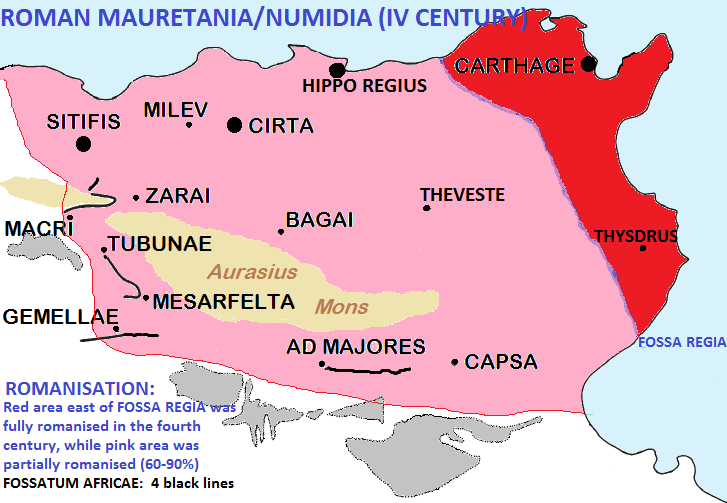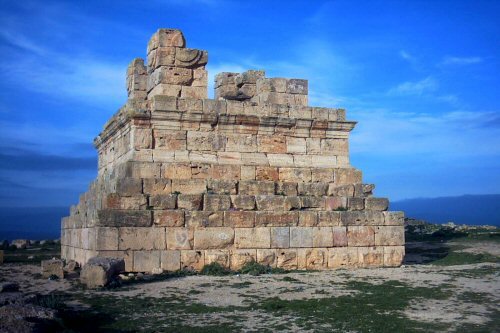|
Roman 'Coloniae' In Berber Africa
Roman colonies in Berber Africa are the cities—populated by Roman citizens—created in Berber North Africa by the Roman Empire, mainly in the period between the reigns of Augustus and Trajan. These colonies were created in the area—now called Tamazgha by the Berbers—located between Morocco and Libyan Tripolitania. Characteristics Since the second half of the first century BC and as a result of increasing communities of Roman citizens living in the North African centers, Rome started to create colonies in North Africa. The main reason was to control the area with Roman citizens, who had been legionaries in many cases. The second reason was to give land and urban properties to the Roman military troops who had fought for the Roman Empire and so decrease the demographic problem in the Italian peninsula. The third reason was to facilitate the Romanization of the area and so the integration of the local Berbers -through marriage and other relationships- in the Roman Empire's so ... [...More Info...] [...Related Items...] OR: [Wikipedia] [Google] [Baidu] |
Caesarea Mauretaniae
Caesarea in Mauretania (Latin: ''Caesarea Mauretaniae'', meaning "Caesarea of Mauretania") was a Roman colony in Roman-Berber North Africa. It was the capital of Mauretania Caesariensis and is now called Cherchell, in modern Algeria. In the present time Caesarea is used as a titular see for Catholic and Eastern Orthodox bishops. History Antiquity to third century AD Phoenicians from Carthage founded a settlement on the northern coast of Africa, 100 km west of the present-day city of Algiers at present Cherchell around 400 BC to serve as a trading station and named the city Iol or Jol. It became a part of the kingdom of Numidia under Jugurtha, who died in 104 BC and it became very significant to the Berber monarchy and generals of Numidia . The Berber Kings Bocchus I and Bocchus II lived there. During the 1st century BC, due to the city’s strategic location, new defences were built. The last Numidian king Juba II and his wife, the Ptolemaic princess Cleopatra Selene ... [...More Info...] [...Related Items...] OR: [Wikipedia] [Google] [Baidu] |
Mauretania Sitifensis
Mauretania Sitifensis was a Roman province in Northwest Africa. The capital was Setifis. History In the later division of the Roman Empire under the Emperor Diocletian, the eastern part of Mauretania Caesariensis, from Saldae to the river Ampsaga, was split into a new province, and called Mauretania Sitifensis named after the inland town of Setifis ( Setif in modern Algeria). At the time of Constantine the Great, Mauretania Sitifensis was assigned to the administrative Diocese of Africa, under the Praetorian prefecture of Italy. The new province had a huge economic development in the 4th century, until the conquest by the Vandals. In this province, the Christian denomination known as Donatism challenged the Roman Church (which was the main local religion after Constantine), while Setifis was a center of Mithraism. After the fall of the Western Roman Empire, certain areas of Mauretania Sitifensis were under Vandal and later Byzantine control, but most of the province (until 578 ... [...More Info...] [...Related Items...] OR: [Wikipedia] [Google] [Baidu] |
Mauretania Tingitana
Mauretania Tingitana (Latin for "Tangerine Mauretania") was a Roman province, coinciding roughly with the northern part of present-day Morocco. The territory stretched from the northern peninsula opposite Gibraltar, to Sala Colonia (or Chellah) and Volubilis to the south, and as far east as the Mulucha (or Malva) river. Its capital city was Tingis, which is the modern Tangier. Other major cities of the province were Iulia Valentia Banasa, Septem, Rusadir, Lixus and Tamuda. History After the death in 40 AD of Ptolemy of Mauretania, the last Ptolemaic ruler of the Kingdom of Mauretania, in about 44 AD Roman Emperor Claudius annexed the kingdom to the Roman Empire and partitioned it into two Roman provinces: Mauretania Tingitana and Mauretania Caesariensis. The Mulucha ( Moulouya River), located around 60 km west of modern Oran, Algeria, became the border separating them. The Roman occupation did not extend very far into the continent. In the far west, the souther ... [...More Info...] [...Related Items...] OR: [Wikipedia] [Google] [Baidu] |
Mauretania Caesariensis
Mauretania Caesariensis (Latin for "Caesarean Mauretania") was a Roman province located in what is now Algeria in the Maghreb. The full name refers to its capital Caesarea Mauretaniae (modern Cherchell). The province had been part of the Kingdom of Mauretania and named for the Mauri people who lived there. Formerly an independent kingdom, and later a client state of Rome, it was annexed into the Empire formally during the reign of Claudius and divided into two provinces about 42 AD. A third province, named Mauretania Sitifensis, was later split off from the eastern portion during the reign of Diocletian in 293 AD. During and after the Fall of the Western Roman Empire in the 5th century, most of the hinterland area was lost, first to the Vandal Kingdom and later to the Mauro-Roman Kingdom, with Roman administration limited to the capital of Caesarea. The land was reconquered by Rome during the reign of Justinian. This province was a part of Praetorian prefecture of Africa, ... [...More Info...] [...Related Items...] OR: [Wikipedia] [Google] [Baidu] |
Numidia
Numidia ( Berber: ''Inumiden''; 202–40 BC) was the ancient kingdom of the Numidians located in northwest Africa, initially comprising the territory that now makes up modern-day Algeria, but later expanding across what is today known as Tunisia, Libya, and some parts of Morocco. The polity was originally divided between the Massylii in the east and the Masaesyli in the west. During the Second Punic War (218–201 BC), Masinissa, king of the Massylii, defeated Syphax of the Masaesyli to unify Numidia into one kingdom. The kingdom began as a sovereign state and later alternated between being a Roman province and a Roman client state. Numidia, at its largest extent, was bordered by Mauretania to the west, at the Moulouya River, Africa Proconsularis to the east, the Mediterranean Sea to the north, and the Sahara to the south. It was one of the first major states in the history of Algeria and the Berbers. History Independence The Greek historians referred to these peoples as ... [...More Info...] [...Related Items...] OR: [Wikipedia] [Google] [Baidu] |
Africa Proconsularis
Africa is the world's second-largest and second-most populous continent, after Asia in both cases. At about 30.3 million km2 (11.7 million square miles) including adjacent islands, it covers 6% of Earth's total surface area and 20% of its land area.Sayre, April Pulley (1999), ''Africa'', Twenty-First Century Books. . With billion people as of , it accounts for about of the world's human population. Africa's population is the youngest amongst all the continents; the median age in 2012 was 19.7, when the worldwide median age was 30.4. Despite a wide range of natural resources, Africa is the least wealthy continent per capita and second-least wealthy by total wealth, behind Oceania. Scholars have attributed this to different factors including geography, climate, tribalism, colonialism, the Cold War, neocolonialism, lack of democracy, and corruption. Despite this low concentration of wealth, recent economic expansion and the large and young population make Af ... [...More Info...] [...Related Items...] OR: [Wikipedia] [Google] [Baidu] |
Military Service
Military service is service by an individual or group in an army or other militia, air forces, and naval forces, whether as a chosen job (volunteer) or as a result of an involuntary draft (conscription). Some nations (e.g., Mexico) require a specific amount of military service from every citizen, except for special cases, such as limitation determined by a military physical or religious belief. In the United States, a mental disorder does not necessarily disqualify a recruit so long as no treatment had been given within 36 months. Most countries that use conscription systems only conscript men; a few countries also conscript women. For example, Norway, Sweden, North Korea, Israel, and Eritrea conscript both men and women. However, only Norway and Sweden have a gender-neutral conscription system, where men and women are conscripted and serve on equal formal terms. Some nations with conscription systems do not enforce them. Nations which conscript for military service typically ... [...More Info...] [...Related Items...] OR: [Wikipedia] [Google] [Baidu] |
Taxation In Ancient Rome
There were four primary kinds of taxation in ancient Rome: a cattle tax, a land tax, customs, and a tax on the profits of any profession. These taxes were typically collected by local aristocrats. The Roman state would set a fixed amount of money each region needed to provide in taxes, and the local officials would decide who paid the taxes and how much they paid. Once collected the taxes would be used to fund the military, create public works, establish trade networks, stimulate the economy, and to fund the '' cursus publicum''. Types The ancient Romans had two classes of taxes: the '' tributa'' and the ''vectigalia''. ''Tributa'' included the '' tributum soli'' (a land tax) and the ''tributum capitis'' (a poll tax). The ''vectigalia'' consisted of four kinds of tax: the '' portoria'' (poll tax), the '' vicesima hereditatium'' (inheritance tax), the '' vicesima liberatis'' ( postage tax), and the '' centesima rerum venalium'' (auction sales tax). Cities may have occasionall ... [...More Info...] [...Related Items...] OR: [Wikipedia] [Google] [Baidu] |
Municipium
In ancient Rome, the Latin term (pl. ) referred to a town or city. Etymologically, the was a social contract among ("duty holders"), or citizens of the town. The duties () were a communal obligation assumed by the in exchange for the privileges and protections of citizenship. Every citizen was a . The distinction of was not made in the Roman Kingdom; instead, the immediate neighbours of the city were invited or compelled to transfer their populations to the urban structure of Rome, where they took up residence in neighbourhoods and became Romans ''per se''. Under the Roman Republic the practical considerations of incorporating communities into the city-state of Rome forced the Romans to devise the concept of , a distinct state under the jurisdiction of Rome. It was necessary to distinguish various types of and other settlements, such as the colony. In the early Roman Empire these distinctions began to disappear; for example, when Pliny the Elder served in the Roman army, ... [...More Info...] [...Related Items...] OR: [Wikipedia] [Google] [Baidu] |
Kairouan
Kairouan (, ), also spelled El Qayrawān or Kairwan ( ar, ٱلْقَيْرَوَان, al-Qayrawān , aeb, script=Latn, Qeirwān ), is the capital of the Kairouan Governorate in Tunisia and a UNESCO World Heritage Site. The city was founded by the Umayyads around 670, in the period of Caliph Mu'awiya (reigned 661–680); this is when it became an important centre for Sunni Islamic scholarship and Quranic learning, attracting Muslims from various parts of the world, next only to Mecca, Medina and Jerusalem. The Mosque of Uqba is situated in the city.Europa Publications "General Survey: Holy Places" ''The Middle East and North Africa 2003'', p. 147. Routledge, 2003. . "The city is regarded as a holy place for Muslims." In 2014, the city had about 187,000 inhabitants. Etymology The name ( ''al-Qayrawān'') is an Arabic word meaning "military group" or "caravan", borrowed early on from the Middle Persian word ''kārawān'' (modern Persian ''kârvân''), meaning "military column" ('' ... [...More Info...] [...Related Items...] OR: [Wikipedia] [Google] [Baidu] |





